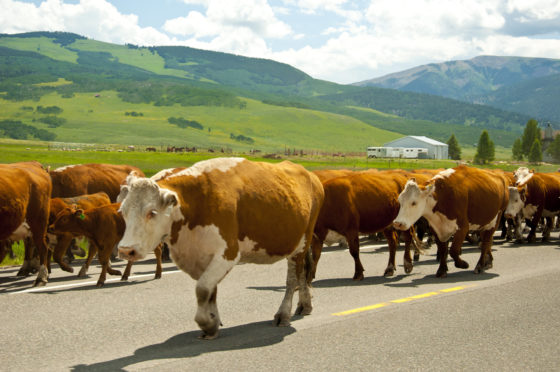A ranching safety advisor reminds drivers to be vigilant and follow ranch workers’ directions when they encounter cattle drives on B.C.’s roads.

Photo credit: iStock.com/Betty4240
Sometimes ranchers in rural B.C. herd their cows along roads. For motorists passing through the region, it can be quite a sight, but it can also be confusing.
“People are driving down a gravel road and then, all of a sudden, they see 200 cows in front of them and they’re just not sure what to do,” says Reg Steward, a provincial ranching safety consultant and superintendent of field operations for AgSafe, B.C.’s health and safety association for agriculture.
“I’ve seen people do everything from honking and putting on their four-way flashers to parking and turning their cars off. I’ve seen cows gather around a car and rub up against it. Or they’ll freeze right on the road trying to figure it out.”
Due to the risk of cow-car collisions, Reg says the best thing motorists can do when they encounter a cattle drive is to look to a ranch worker — who may be travelling alongside the cattle on foot, ATV, or horseback — for instructions on what to do. If you can’t get a worker’s attention or don’t see one, typically it’s best to just keep driving forward slowly, through the cattle, and the herd will part.

Close-up view of a cattle guard across a rural highway
Photo credit: iStock.com/Tatsuo115
Reg says motorists will know they’re in open range cattle country (where cattle can be on roadways) when they observe open range signs and they encounter cattle guards on the road. A cattle guard is usually a grid of metal bars or tubes across a dug-out strip of the road. Vehicles can drive over it but the visual barrier created by the spaces in the grid prevents cattle from trying to walk across.
“These guards are a signal to motorists that there could be cattle in the area, and to be vigilant by slowing down, taking a look, and keeping aware.”
Procedures required for cattle transports on roads
Ranchers are required to obtain permits and follow procedures when planning cattle drives that cross a provincial highway. Procedures differ depending on how many cars travel on the highway.
For more information about this, see Planning a cattle drive along B.C.’s highways, and Mooo-ving along B.C. highways from TranBC. Also see AgSafe’s Ranching Safety Program.
Many thanks to Reg for telling me about his work. Do you have any stories about cows on roads? If so, I’d love to know, so please do tell in the Comments below.



I remember as a kid driving with my family on a backroad somewhere outside Greenwood when suddenly, around a curve in the road, there was a giant black bull standing in front of us. Boy was I ever glad when we reversed back over the cattle guard we’d crossed earlier.
Wow! Thanks for sharing this memory — not something one would forget!
Pingback: Sharing the roads with cattle - World of Safety and Health Asia